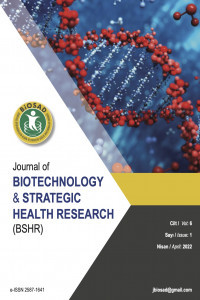59 Tuboovaryan Abse Olgusunun Klı̇nı̇k Yönetı̇mı̇
Cerrahi tedavi, Medikal tedavi, Pelvik inflamatuar hastalık, Tubo-ovaryen abse
The Clinical Management Of 59 Tubo-Ovarıan Abscess Cases
___
- 1. Brunham RC, Gottlieb SL, Paavonen J. Pelvic inflammatory disease. N Engl J Med. 2015;372:2039–2048.
- 2. Kim HY, Yang JI, Moon C. Comparison of severe pelvic inflammatory disease, Pyosalpinx and tubo-ovarian abscess. J Obstet Gynaecol Res. 2015;41:742–746.
- 3. Beigi RH, Wiesenfeld HC. Pelvic inflammatory disease: new diagnostic criteria and treatment. Obstet Gyne- col Clin North Am 2003; (30):777-793. 4. Granberg S, Gjelland K, Ekerhovd E. The management of pelvic abscess. Best Pract Res Clin Obstet Gynaecol. 2009;23:667–678.
- 5. Lareau SM and Beigi RH. “Pelvic inflammatory disease and tubo-ovarian abscess”. Infectious Diseases Clinics of North America 22.4 (2008): 693-708. 6. Zhao WH, Hao M. Pelvic inflammatory disease: A retrospective clinical analysis of 1,922 cases in North China. Gynecol Obstet Invest. 2014;77:169–175. 7. Hiller N, Sella T, Lev-Sagi A, Fields S, Lieberman S. Computed tomographic features of tuboovarian abscess. J Reprod Med 2005;50(3):203-208.
- 8. Gencdal S, Aydogmus H. Evaluation of Surgical Treatment in Patients with Ruptured Tubo-Ovarian Abscess in Our Clinics. EC Gynaecology 4.6 (2017): 198-203.
- 9. Fouks, Y., Cohen, A., Shapira, U., Solomon, N., Almog, B., & Levin, I. Surgical intervention in patients with tubo-ovarian abscess: clinical predictors and a simple risk score. Journal of Minimally Invasive Gynecology, 2019;26(3), 535-543.
- 10. Granberg S, Gjelland K, Ekerhovd E. ‘’Best practice and research’’ Clinical Obstetrics and Gynecology, 2009; 23:667-678.
- 11. Centers for Disease Control and Prevention, Sexually Transmitted Diseases Treatment Guidelines, 2010.
- 12. Hsiao SM, Hsieh FJ, Lien YR. Tuboovarian abscesses in postmenopausal women. Taiwan J Obstet. Gynecol.2006;45(3):234-238.
- 13. Chappell CA, Wiesenfeld HC. Pathogenesis, diagnosis, and management of severe pelvic inflammatory disease and tuboovarian abscess. Clin Obstet Gynecol. 2012;55:893–903.
- 14. Reljic M, Gorisek B. C-reactive protein and the treatment of pelvic inflammatory disease. International journal of gynaecology and obstetrics: the official organ of the International Federation of Gynaecology and Obstetrics. 1998;60:143-150.
- 15. Curry, Amy, Tracy Williams, Melissa L. Penny K.. “Pelvic inflammatory disease: diagnosis, management, and prevention.” American family physician 2019;100.6:357-364.
- 16. Levin, G., Dior, U. P., Gilad, R. “Pelvic inflammatory disease among users and non-users of an intrauterine device.” Journal of Obstetrics and Gynaecology 41.1 (2021): 118-123.
- 17. Turan V, Yeniel Ö, Terek MC, Ulukuş M. Ege Üniversitesi Kadın Hastalıkları ve Doğum Kliniğinde Tuboovaryan Abselerin 5 Yıllık Değerlendirilmesi. Turkiye Klinikleri J Gynecol Obst 2009; 19:349-353.
- 18. Karakulak M, Aydın Y, Bahadır S, Güçlü S. Evaluation of the cases with tuboovarian abscesses. DEÜ Tip Fakültesi Dergisi. 2008; 22:9-13. 19. Dewitt J, Reining A, Allsworth JE, Peipert JF. Tuboovarian abscesses: is size associated with duration of hospitalisation & complications? Obstetrics and gynecology international 2010;2010:847041.
- 20. Reed SD, Landers DV, Sweet RL. Antibiotic treatment of tuboovarian abscess: comparison of broad-spectrum beta-lactam agents versus clindamycin-containing regimens. American journal of obstetrics and gynecology. 1991;164:1556-1561.
- 21. Goje, O., Markwei, M., Kollikonda, S., Chavan, M., & Soper, D. E. “Outcomes of minimally invasive management of tubo-ovarian abscess: a systematic review.” Journal of minimally invasive gynecology 28.3 (2021): 556-564.
- 22. Gjelland K, Ekerhovd E, Granberg S. Transvaginal ultrasound-guided aspiration for treatment of tubo-ovarian abscess: a study of 302 cases. Am J Obstet Gynecol. 2005 Oct;193(4):1323-1330.
- 23. Rosen M, Breitkopf D, Waud K. Tubo-ovarian abscess management options for women who desire fertility. Obstetrical & gynecological survey. 2009;64:681-689.
- 24. Wagner A, Russell C, Ponterio JM, Pessolano JC. Ruptured tuboovarian abscess and septic shock with Clostridium perfringens in a postmenopausal woman: a case report. J Reprod Med. 2009;54(10):652-654.
- 25. Chu L, Ma H, Liang J, Li L, Shen A, Wang J, Li H, Tong X. Effectiveness and Adverse Events of Early Laparoscopic Therapy versus Conservative Treatment for Tubo-Ovarian or Pelvic Abscess: A Single-Center Retrospective Cohort Study. Gynecol Obstet Invest. 2019;84(4):334-342.
- Yayın Aralığı: Yılda 3 Sayı
- Başlangıç: 2017
- Yayıncı: Deneysel, Biyoteknolojik, Klinik ve Stratejik Sağlık Araştırmaları Derneği
Maymun Çiçeği Virüsüne Karşı Antiviral Yaklaşım ve Bağışıklık
Monkeypox Virüsü; Dünya ve Türkiye Epidemiyolojisi
Ülkelerin Covid-19 Hastalığı Fatalite Hızlarıyla İlişkili Faktörlerin Araştırılması
Elif Nur YILDIRIM ÖZTÜRK, Mustafa ÖZTÜRK, Mehmet UYAR
Solid Organ Transplantasyonunda Sitomegalovirüs Üzerine En Etkili Makalelerin Nicel Bir Çalışması
Sevil ALKAN, Oruç Numan GÖKÇE, Mustafa Serhat ŞAHİNOĞLU
59 Tuboovaryan Abse Olgusunun Klı̇nı̇k Yönetı̇mı̇
Feyza BAYRAM, Mehmet Musa ASLAN
Maymun Çiçeğinin Klinik Özellikleri
Sağlık Çalışanları Arasında COVID-19 Aşı Tereddütlüğü ve Aşı Reddi Nedenlerinin Araştırılması
Emine Kübra DİNDAR DEMİRAY, Sevil ALKAN, Hatice ÖNTÜRK AKYÜZ
Rotavirüs Aşısı Çalışmalarında Küresel Trendler
Primer İmmün Yetmezlik ve Malignite Birlikteliği: İki Olgu Sunumu
Ümmügülsüm DİKİCİ, Öner ÖZDEMİR, Emine Aylin YILMAZ, Mehmet Fatih ORHAN
Sağlık Çalışanlarının COVID-19 Aşısı Yaptırma Konusundaki Tutumlarını Etkileyen Faktörler
Sinan YILMAZ, Büşra ULAŞTEPE, Zahide KOŞAN, Serhat VANÇELİK, Emine PARLAK, Sibel İBA YILMAZ
